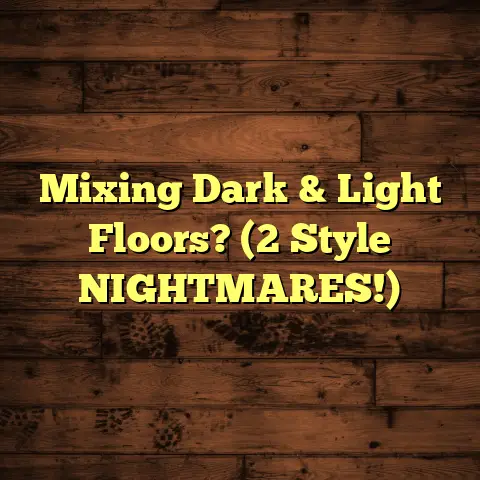Latex Paint On Concrete? (3 Costly Risks!)
When it comes to durability, concrete is often king.
It’s a popular choice for indoor and outdoor spaces
because it’s tough, lasts forever (almost!),
and doesn’t need a ton of upkeep.
But here’s the thing: slapping on latex paint isn’t
always the best idea.
Sure, it can make your
concrete look snazzy, but it also comes with risks
that can mess with your floor’s integrity.
Let’s dive into why that is!
Understanding Latex Paint and Its Composition
So, what exactly is latex paint?
Well, it’s a water-based paint known for being easy to
apply, quick to dry, and relatively low in VOCs
(volatile organic compounds).
You’ll find it everywhere
– from walls and ceilings to trim and, yes, even floors.
Latex paint is a mix of:
- Water: Acts as the carrier for the other ingredients.
- Binders: Hold the pigment together and help the paint stick to the surface.
- Pigments: Give the paint its color.
- Additives: Boost specific properties like durability, mildew resistance, and flow.
Now, how is it different from other paints, like oil-based ones?
Latex paint is more flexible and breathable than
oil-based paint.
It’s also easier to clean up (just
soap and water!).
That’s why it’s a favorite for
concrete surfaces.
The Appeal of Painting Concrete
Why do people paint concrete anyway?
I’ve seen homeowners and businesses do it for a bunch
of reasons.
The most common include:
- Aesthetic enhancement: A fresh coat of paint can instantly transform a dull, gray slab into something eye-catching.
- Color customization: You can choose any color under the sun to match your style or brand.
- Protection from wear and tear: Paint can act as a barrier against scratches, stains, and the elements.
Think about it: Garages, patios, driveways, basements… these are all places where latex paint can make a concrete surface look and perform better.
But, remember those risks I mentioned? Let’s get to them.
Risk #1 – Poor Adhesion and Peeling
This is a big one.
Ever seen paint peeling off a wall or floor?
It’s not
pretty, and it’s usually due to poor adhesion.
Concrete is porous, meaning it has tiny holes that can trap moisture and prevent paint from bonding properly.
Other factors that can cause adhesion issues are:
- Surface preparation: If the concrete isn’t cleaned and prepped correctly, the paint won’t stick.
- Moisture levels: Too much moisture in the concrete can interfere with the paint’s ability to adhere.
- Old coatings: Paint applied over existing coatings that are already failing is likely to peel.
I’ve seen jobs where the homeowner skipped the priming
step, and within months, the paint was bubbling and
flaking off.
It’s a mess, and it means you have to
redo the whole thing.
Peeling paint isn’t just ugly; it also leaves your concrete exposed to the elements, which can lead to further damage.
Risk #2 – Moisture Trapping and Damage
Here’s another potential headache: moisture.
While latex paint is breathable to some extent, it’s
not fully impermeable.
That means it can trap moisture
underneath its surface.
Now, why is that a problem?
Well, trapped moisture can lead to:
- Mold and mildew growth: Damp, dark environments are breeding grounds for these nasties.
- Surface deterioration: Moisture can weaken the concrete, causing it to crack, crumble, or spall (flake off in layers).
- Structural damage: In severe cases, moisture can even compromise the structural integrity of the concrete.
I once worked on a basement where the painted concrete
floor had a persistent musty smell.
Turns out, moisture
was trapped under the paint, and mold was growing like
crazy.
We had to remove the paint, treat the mold, and
install a proper moisture barrier before re-coating the
floor.
Risk #3 – Reduced Longevity and Increased Maintenance
Finally, let’s talk about longevity and maintenance.
Even if the paint adheres well and you don’t have moisture issues, painted concrete simply doesn’t last as long as unpainted concrete.
Think about it: foot traffic, UV exposure, temperature changes… all these things take a toll on the paint.
According to a study by the Portland Cement Association, painted concrete surfaces can experience a 20-30% reduction in lifespan compared to unpainted surfaces, depending on environmental conditions and usage.
That means you’ll need to:
- Touch up the paint regularly: To fix scratches, chips, and fading.
- Reseal the surface: To protect the paint from moisture and wear.
- Repaint the entire surface: Every few years to keep it looking fresh.
All that adds up to extra time, effort, and money.
Sometimes, it’s more cost-effective to choose a
different flooring option altogether.
Conclusion
So, there you have it: the three costly risks of using latex paint on concrete.
To recap, you risk:
- Poor adhesion and peeling.
- Moisture trapping and damage.
- Reduced longevity and increased maintenance.
While latex paint can make your concrete look good in the short term, the long-term consequences may outweigh the benefits.
Before you reach for that paint can, take a step back
and consider all the factors.
Is it really the best
choice for your concrete floor?
There are many other options out there, like concrete stains, epoxy coatings, and sealers, that may be more durable and longer-lasting.
Do your research, talk to a professional (like me!),
and make an informed decision.
Your concrete floor
will thank you for it!





